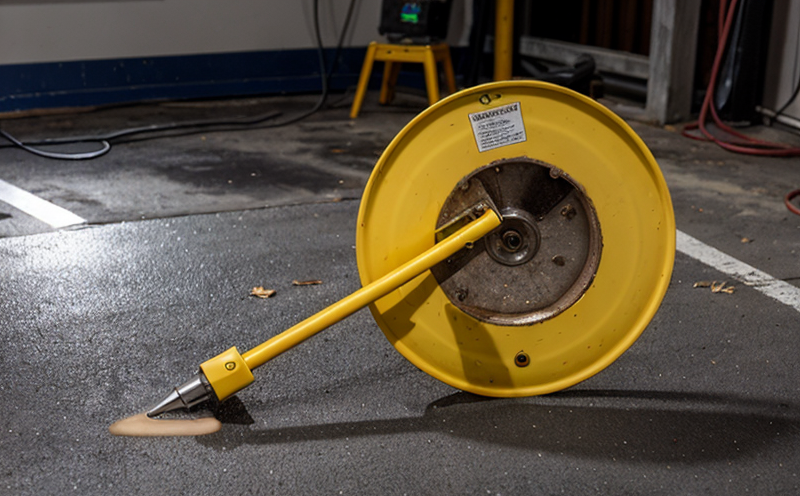ISO 3057 Magnetic Particle Examination of Steel Materials
The ISO 3057 standard specifies the requirements and procedures for magnetic particle examination (MPI) of ferromagnetic materials. This non-destructive evaluation method is widely used in manufacturing, quality assurance, and research to detect surface and near-surface defects in steel parts. The process involves applying a magnetic field to the material being tested, followed by the application of magnetic particles that are attracted to areas with discontinuities or flaws in the part's structure.
Magnetic particle inspection is particularly valuable for identifying cracks, voids, porosity, and other surface imperfections in steel components. Common applications include aerospace manufacturing, automotive engineering, and medical device fabrication, where quality assurance measures are critical to ensure safety and performance. The method is also used extensively in the repair and maintenance of existing structures like pipelines, pressure vessels, and aircraft frames.
The testing process begins with thorough preparation of the specimen, ensuring it is clean and free from oil, grease, or other contaminants that could interfere with the magnetic field. Once prepared, a suitable magnetizing current is applied to induce a magnetic flux in the material. Magnetic particles are then introduced into the field, allowing them to concentrate at defect sites where the magnetic flux lines are disrupted.
For effective MPI, it's essential to use appropriate types and concentrations of magnetic particles. The most common types include dry or wet particles, depending on the specific requirements of the test. Dry particles are applied directly onto the surface of the part being tested, while wet particles require the application of a carrier fluid that helps spread the particles across the surface.
The results of an MPI can be visually inspected using different lighting techniques such as white light, UV light, or black light. The presence of defects is indicated by visible accumulations of magnetic particles at these locations. This visual inspection allows for detailed analysis and documentation of any flaws detected during the examination process.
Compliance with ISO 3057 ensures that testing meets international quality standards, which is crucial for manufacturers operating in global markets or those seeking to adhere to specific regulatory requirements. The standard provides clear guidelines on pre-test preparation, test procedures, inspection techniques, and post-test documentation, ensuring consistent and reliable results.
Understanding the nuances of MPI can help quality managers, compliance officers, R&D engineers, and procurement specialists make informed decisions about testing protocols and material specifications. By leveraging this knowledge, they can enhance product reliability and safety while optimizing production processes.
Why It Matters
The ISO 3057 Magnetic Particle Examination of Steel Materials is a critical tool in ensuring the integrity and quality of steel components used across various industries. In sectors like aerospace, automotive, and medical device manufacturing, where failures can lead to catastrophic consequences, the ability to detect surface and near-surface defects early on is paramount.
By adhering to ISO 3057 standards, manufacturers can demonstrate their commitment to quality and compliance with international regulations. This not only enhances product reliability but also builds trust with customers who demand high-quality products. For R&D engineers, MPI provides a valuable method for evaluating new materials and processes before full-scale production.
The non-destructive nature of MPI allows for repeated testing without compromising the integrity of the component being examined, making it an essential part of ongoing quality assurance programs. This ensures that defective parts are identified early in the manufacturing process, reducing waste and improving overall efficiency.
In summary, ISO 3057 Magnetic Particle Examination is a cornerstone of modern industrial quality control practices. Its ability to detect imperfections with precision and reliability makes it indispensable for maintaining product safety and performance across various industries.
Applied Standards
The ISO 3057 standard for magnetic particle examination of steel materials is part of a broader set of international standards aimed at ensuring the quality and integrity of ferromagnetic materials. These include:
- ISO 17648-2: Non-destructive testing — Magnetic Particle Testing (MPI) Part 2: Methods
- ASTM E1444: Standard Practice for Interpreting the Results of Magnetic Particle Inspections
- EN 50978-3: Non-destructive testing — Magnetic particle testing (MPI) Part 3: Methods and test procedures
These standards provide comprehensive guidance on MPI, covering everything from pre-test preparations to post-inspection documentation. They ensure that the testing process is standardized across different regions and industries, facilitating international collaboration and trade.
The application of ISO 3057 in conjunction with these other standards helps manufacturers achieve consistent results and enhances their reputation for quality assurance. Compliance with these standards also opens up market opportunities by aligning with global regulatory requirements.
Eurolab Advantages
At Eurolab, we pride ourselves on offering comprehensive testing services that meet the highest international standards. Our expertise in ISO 3057 Magnetic Particle Examination of Steel Materials is backed by years of experience and cutting-edge equipment.
We employ highly skilled technicians who are certified to perform MPI according to ISO 3057 guidelines. Our state-of-the-art facilities provide a controlled environment for specimen preparation, ensuring that each test meets the stringent requirements specified in the standard.
Our commitment to quality is further demonstrated through our use of advanced magnetic particle testing equipment and sophisticated data analysis tools. This allows us to provide detailed reports that not only document the results of the test but also offer valuable insights into potential areas for improvement.
In addition to strict adherence to ISO 3057, we maintain rigorous quality control measures throughout the entire testing process. From initial consultation with clients to final report generation, every step is meticulously documented and verified. This ensures that our services are reliable, accurate, and consistent.
Our customers benefit from our ability to provide rapid turnaround times without compromising on accuracy or thoroughness. We understand the importance of timely results in maintaining production schedules and can accommodate urgent requests as needed.
Moreover, Eurolab offers additional value-added services such as training programs for personnel involved in MPI testing. This helps ensure that staff members are up-to-date with the latest techniques and best practices, further enhancing the quality of our services.





